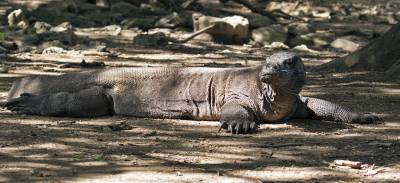My Blog - Jeff Clarke
Updates and photos from around the world on my travels both through pleasure and work
Black Watch - Sector Five (Part 2 - Komodo and Beyond)
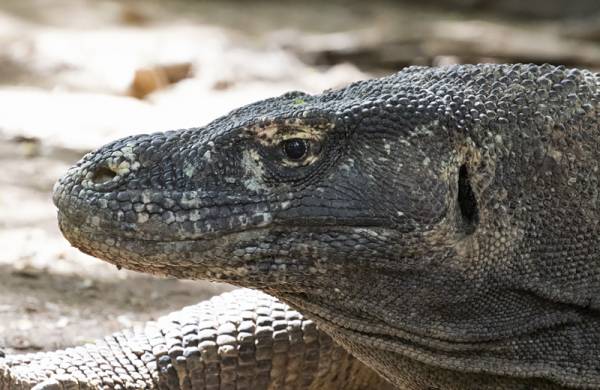
By the dawn of the 10th March Australia had long receded from the aft deck view as Black Watch set course for a true ‘Wonder of the World’ in the shape of Komodo Island and its infamous dragons. We would have two full days crossing the Timor and Savu seas before reaching Komodo and I anticipated some good cetacean action once we hit the deeper waters.
On the 10th there were plenty of birds to see, with over 100 Streaked Shearwater and a similar number of Sooty Terns being by far the dominant bird two species, but they never really came close enough to the ship for photography purposes. Flying fish were the most numerous living things and thousands scattered like starbursts as the ship’s bow wave pulsed through their bodies.
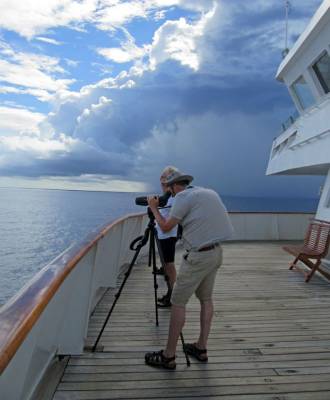
Scouring the Ocean off Deck 7 © Adele Clarke
Click on image to view at full size
Our second day at sea since Darwin was a different kettle of fish, as we hit an area of deeper water and a seabed full of convolutions. This created the dynamic marine maelstrom that brings nutrients to the surface and fuels the fires of a feeding frenzy right through the food chain. Hopes were high as the sun rose. I could feel it in my bones. Time to light the blue touchpaper…
From the off we had pods of ‘offshore’ Common Bottlenose Dolphins leaping in towards the bow and these were quickly followed by ‘Dwarf’ Spinners. During the morning deck-watch we had more ‘Dwarf’ Spinners. Then in the in the distance ahead of the bow four larger animals surfaced. They disappeared for prolonged periods before surfacing again in unison. They disappeared once again and I still wasn’t certain what they were. The reappeared briefly head-on and the penny finally dropped. They were Risso’s Dolphins and with that they dived again.

Bottlenose Dolphin calf © Jeff Clarke
Just as the deck-watch was coming to an end we hit a rich seam of cetaceans. In the distance the log-like form of Short-finned pilot whales lay languidly in the placid waters. There were several pods all in close proximity to each other. I alerted the watchful passengers and mentioned their frequent association with other species, in particular Bottlenose Dolphins. As we closed in on them it was clear there were dolphins with them. As they sensed the ship’s approach they detached themselves from the pilot whales and ‘porpoised’ in to bow ride. They went aerial allowing me to capture a few images of them mid-leap. These were big and noticeably bulky ‘offshore’ Bottlenose Dolphins.
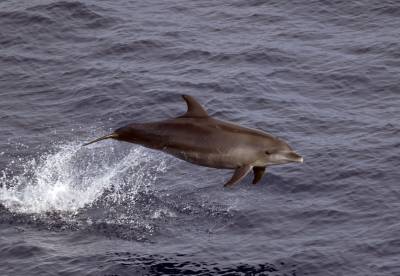
'Offshore' Bottlenose Dolphin makes for Black Watch © Jeff Clarke
Just on 10.00am more fins appeared in the water. There was something different about these animals and the pod comprised approximately 30 animals. They were small ‘blackfish’ but just as I thought we would get a close look at them they dived and didn’t reappear until far in our wake. They were either Melon-headed Whale (AKA Electra Dolphins) or Pygmy Killer Whales, but I didn’t see enough detail to put a name to them. A frustrating but common situation for even the most experienced whale and dolphin watcher. They went down in the log as dolphin sp.
Later in the morning a lone booby out to port side was clearly whiter than the other booby species we had seen on the trip so far and I initially assumed it would be a sub-adult Masked Booby. It took a second look for me realise it was the wrong shape. It passed by distantly several times and I became convinced it was an Abbott’s Booby. I managed some very poor record shots but they were enough to prove my suspicions were correct. This species only breeds on Christmas Island. Before the trip I’d considered it a possibility but assumed it would be a long shot, so this was a real bonus bird.
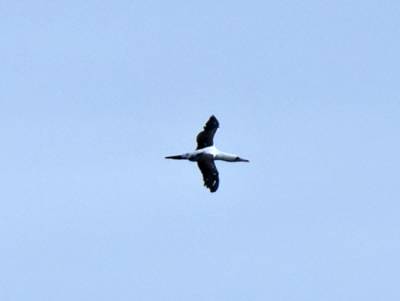
Abbott's Booby (record shot) © Jeff Clarke
Rather easier to photograph was Red-footed Booby, later that day one that spent a good 30 minutes taking advantage of the ship’s tendency to scatter the flying fish by promptly chasing them down with varying degrees of success. The commonest booby of the day was the Brown Booby, over 100 hove into view, most of them late in the day.
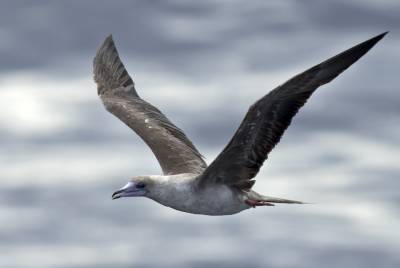
Red-footed Booby (brown phase) © Jeff Clarke
Late in the afternoon the dolphin show began again. Some way ahead to starboard I could see a lot of fins on the surface. Clearly there was a sizeable pod of resting dolphins. They looked very dark and their dorsal shape had me thinking once again they were a small blackfish species. As they got closer I grew more confident. I began taking photographs and noticed there were some other dolphins mixed in with a different dorsal shape, a small group leapt in unison. The profile of those dolphins burned on to my retinas, but I scarcely dared believe what I’d seen. I scanned and rescanned. A few heads popped up spy-hopping and I was able to confirm the dark dolphins were Melon-headed Whales, I also managed a few images which confirmed it. I hammered out more pictures of the group as they passed distantly by and sure enough my photographs conclusively showed their true identity of the other dolphins in the group. They were Frasers Dolphins! The folks gathered with me on deck 10 knew this must be something significant as I punched the air with a clenched fist and shouted “come-on!”
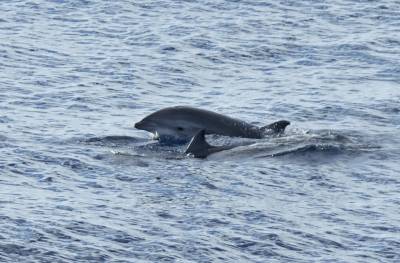
Fraser's Dolphin © Jeff Clarke
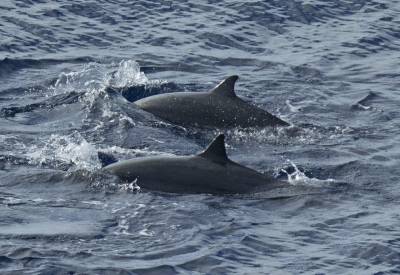
Fraser's Dolphins female (top) male (bottom) © Jeff Clarke
They were witnessing one of the special wildlife moments of my life and here’s why. Frasers Dolphin was unknown to science until 1956, when a skull, collected in 1895, was finally studied by a cetologist called Francis Fraser. He declared it a new species and the animal was not seen in the wild by any cetologists until 1971. It’s now understood not to be quite as rare as was once thought but still very few people can claim to have seen one alive. By the end of the day we had amassed two further pods of Frasers Dolphin, totalling a minimum of 120 individuals. One pod came close enough, in their typically tight boiling mass to attract the attention of many folks sunbathing on the rear of Black Watch. It is for such moments that I invest so much time staring out to sea from the decks of ocean going vessels.
We ended our watch with a spectacular fireball sunset before I completed the daily wildlife log. I did this each evening on the ship, before placing it on the library table for the other passengers to peruse. On the top of the sheet that evening I wrote “Simply Amazing Dolphin Day”. Enough said!
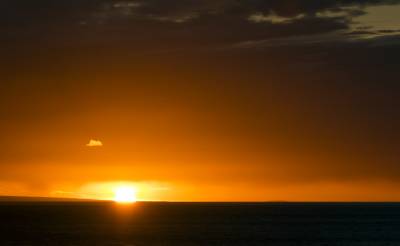
Fireball Sunset © Jeff Clarke
Up before sunrise (again) on the 12th for the cruise into our anchorage at Komodo Island. Blissfully calm and stunning scenery and just to top it off a pod of ‘inshore’ Common Bottlenose played on the bow of Black Watch to herald our arrival.
After a short period we were ready to be tendered ashore and headed for a rendezvous with the fabled Komodo Dragon. We had been ashore barely moments when a juvenile dragon hove into view. The guides carry forked sticks for a reason. It’s not wise to get bitten by a dragon, the outcome may be terminal. Formerly it was believed bacterial infection would overwhelm those escaping the initial attack by a dragon, but new research suggests that they are venomous and that it is the venom, blood loss and trauma that causes death in their prey (though this is still in dispute by some authorities).
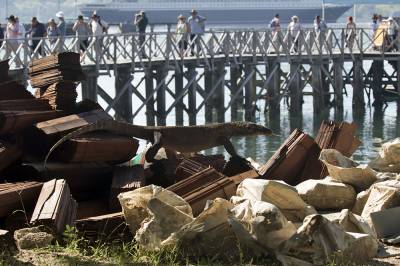
Immature Komodo Dragon near tender jetty © Jeff Clarke
After a short trek through the forest we reached a clearing. Here were three mature male dragons resting by a dried-up pool. The high heat and humidity of the day meant they were already lethargic. Even so it was wise not to disregard the potential threat.
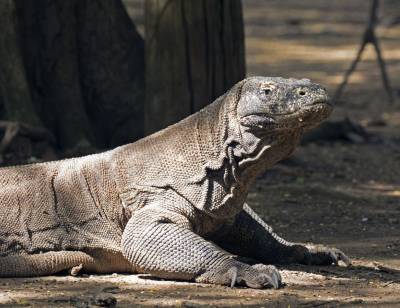
 \
\
Adult male Komodo Dragon © Jeff Clarke
Having duly admired these recumbent beasts we trekked back toward the jetty via a different route. Another sub-adult Komodo Dragon was mooching around the beach area. A fitting gift before we departed for the ‘Pink Beach’.
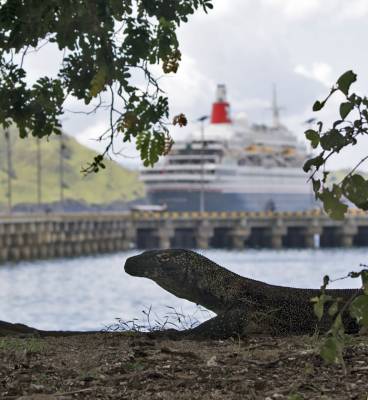
Sub-adult Komodo Dragon and Black Watch © Jeff Clarke
It was a chance for another snorkelling session. Here the reef starts only a few metres from the beach itself and doing this tour turned out to be a good decision. The reef was in great condition and the diversity and abundance of fish was hard to comprehend. It was also the first time I have succeeded in getting Adele out snorkelling properly. We both had a ball. If you ever visit Komodo don’t miss out on snorkelling here. (I wore a T-shirt to stop my back from burning, however I forgot about my legs and they had turned a startling shade of pink after a couple of hours!)
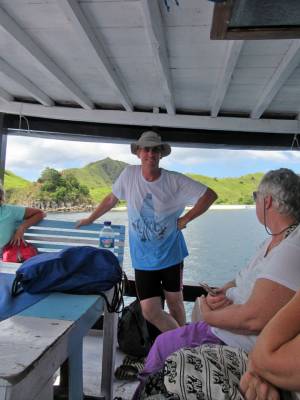
Wearing my Ocean Plastic T-Shirt at Pink Beach © Adele Clarke
As we waited to return to our small passenger boat I scanned the trees and bushes for birdlife. Most, like the Collared Kingfisher and Greater Coucal were too far away for satisfactory photography but at least the local Lemon-bellied White-eyes came close.

Lemon-bellied White-eye © Jeff Clarke
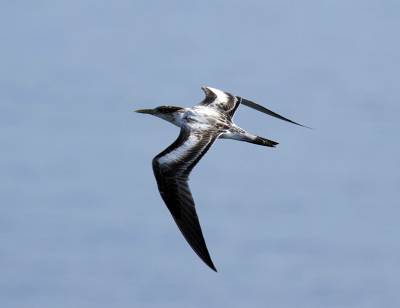
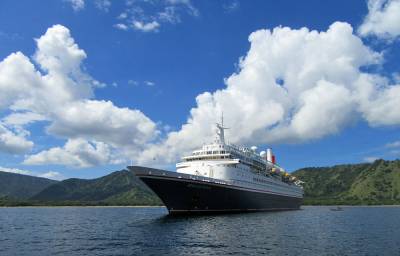
Crested Tern (juv) and Black Watch anchored off Komodo Island © Jeff Clarke
We returned to the ship in high spirits and excited about the cetacean prospects as we departed Komodo Island. A juvenile Crested Tern flew close to the ship as the anchor was lifted and we had barely got underway when we were joined by some rather small and pale Bottlenose Dolphins, they appeared to be Indo-Pacific Bottlenose but my images were inconclusive. As we ventured out to deeper water they disappeared but were soon replaced by bigger darker bottlenose.
By the time we hit the really deep water most of the passengers had headed below decks. This was a pity as a huge explosion in the water probably 3 miles ahead of the ship heralded the appearance of a pod of Sperm Whales. Their characteristic blows suggested a minimum of 10 animals at the surface. A couple of animals indulged in tail slapping and spyhopping. They weren’t close enough for photography purposes but I did get a few folks onto them through the scope. A Rorqual whale ‘blew’ in between them but we never saw the animal itself.

Mt. Agung erupting on Bali © Jeff Clarke
As the sun began to set Adele an I were left on our own to enjoy the vista of Mount Agung erupting in the far distance. The Savu Sea had one more gift to bestow as another pod of Fraser’s Dolphin boiled in the water off our port side. What a special and rare day this had been.
As dawn rose on the 13th we were headed through the Lombok Strait. It quickly became apparent just how rich this location was for cetaceans. A large scattered pod of ‘Offshore’ Bottlenose Dolphins sped around the ship and they were soon followed by several pods of Spinner Dolphins. We also had a small pod of False Killer Whale.
Alongside the cetaceans we had a good mix of seabirds, again dominated by Brown and Red-footed Boobies but it also included several new species for the trip, namely, 3 Long-tailed Skuas, a couple of ‘bengalensis’ Lesser Crested Tern and, best of all, a sub-adult White-tailed Tropicbird that briefly overflew the small gathered group on deck 10.
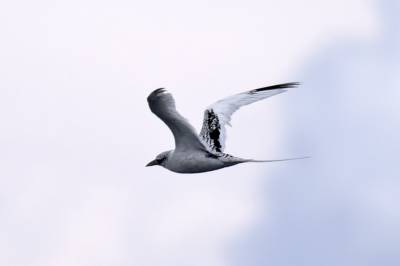
White-tailed Tropicbird (sub-adult) © Jeff Clarke
Around 2.00pm came our last big dolphin moment of the cruise when a huge pod, 200+ Melon-headed Whale surfaced a quarter mile off our port side.
The next two days at sea were something of an anti-climax. The Java Sea and Karimata Strait are fairly shallow and on this occasion were fairly devoid of birds and dolphins (though we would spot the occasional sea snake and some tuna boils to keep some interest going). Sadly, one of the most indelible impressions in this stretch of sea is the catastrophic level of plastic pollution throughout the water column. Most of it must be entering the Java Sea through the surrounding river systems of Indonesia and Malaysia.
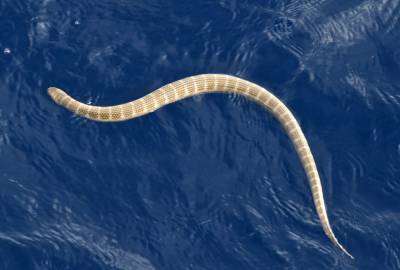

Sea Snake sp. & symbolic Plastic Bottle in the Java Sea © Jeff Clarke
There is hope in this part of the world and its shining beacon is Singapore. I’d heard good things about Singapore, but it surpassed all my expectations. We didn’t have particularly long in port, so we decided to do one thing well. We chose the Gardens by the Bay and it delivered on all levels.
Gardens by the Bay is a very recent development, but it is already recognised as one of the great destination locations, an amazing marrying together of human constructions and the natural environment into something astonishing. The Cloud Forest and Flower Domes make you think “eat your heart out Eden Project’. It is still developing and can only get even better, if you visit nowhere else in Singapore this is a ‘must do’ location.
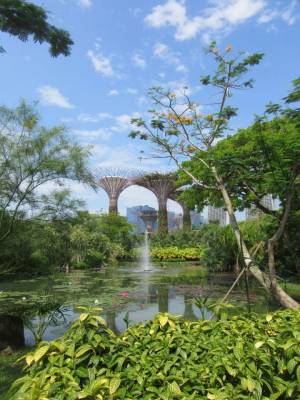
Gardens by the Bay, Singapore © Adele Clarke
Not only that but it was superb for birds and I found some great stuff in the grounds and even managed to some decent photographs. We had barely got started when Blue-tailed Bee-eaters greeted us at the entrance. A little further on an we witnessed a Yellow-vented Bulbul capture and kill a lizard. A little judicious ‘pishing’ attracted the attention of many small passerines including Common and Ashy Tailorbirds as well as the resplendent Olive-backed Sunbirds. The two highlights were probably a pair of mating Collared Kingfishers and a Common Goldenback Woodpecker. Time caught up with us and we headed back to the ship wishing we had a late-night departure.
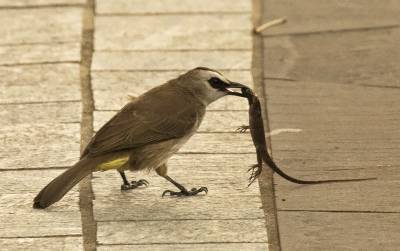
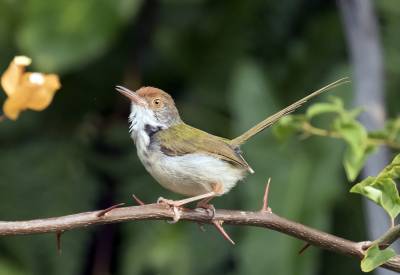
Yellow-vented Bulbul & Common Tailorbird © Jeff Clarke

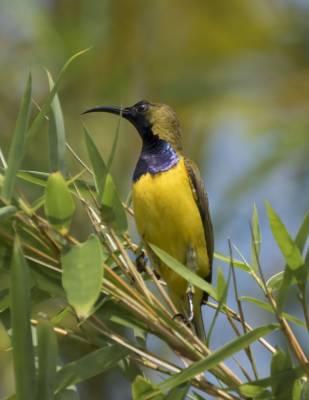
Ashy Tailorbird & Olive-backed Sunbird © Jeff Clarke
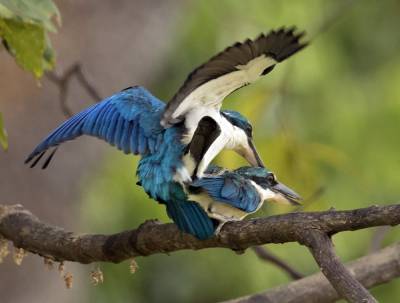
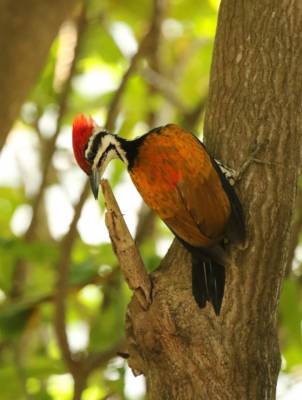
Collared Kingfishers mating & Common Goldenback Woodpecker © Jeff Clarke
Back on board the ship, after a quick freshen up, I was soon on the top deck. I had my telescope and both cameras to hand as the ship prepared to depart. A movement out of the corner of my eye homed in on a White-bellied Sea Eagle that had just captured a large fish in the harbour. Luckily it passed reasonably close and my shutter rapid-fired a lovely sequence of shots as the bird was lit by the low sun. It was a species I’ve seen many times, but never really got that close to previously, so it was a very satisfying end to a cracking day. What’s more an immature bird came for a close pass only minutes later.
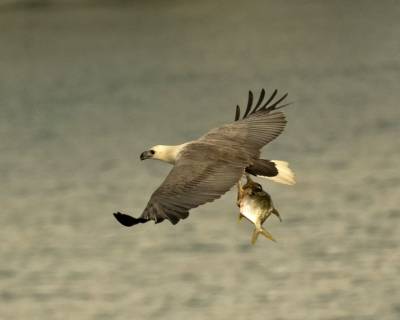
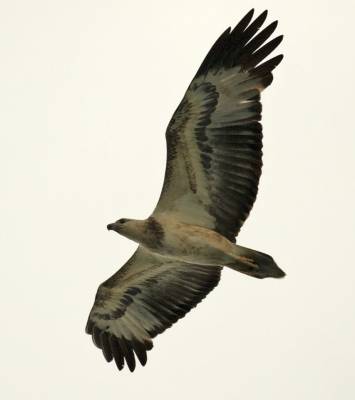
White-bellied Sea-Eagle Adult & immature © Jeff Clarke
The following morning, I was up at dawn to see Black Watch dock at Port Klang. We didn’t leave to catch our flight till 2:30pm so I enjoyed a few hours exploring some interesting habitat, including mangroves, within walking distance of the Bousted Cruise Terminal. Most birds evaded the camera, though I managed an interesting record shot of a male Asian Koel (a type of Cuckoo) presenting a fruit to his female partner. An adult Brahminy Kite did a reasonably close fly-by and a Blue-tailed Bee-eater eating a dragonfly prey we also captured for posterity.
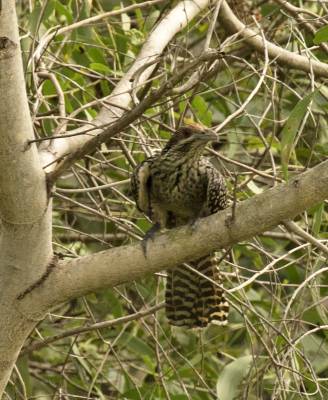
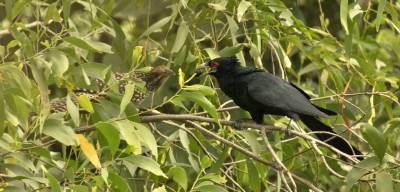
Asian Koel female (left) & Male feeding female (right) © Jeff Clarke


Brahminy Kite (adult) & Blue-tailed Bee-eater © Jeff Clarke
Minutes before leaving the ship my final addition to the trip list was a troop of Long-tailed Macaques observed from deck 7 of Black Watch. I got a couple of the passengers on to the animals before they were disturbed by some local fishermen.
So that was it. It had been a fabulous journey aboard Black Watch, we had been privileged to enjoy so many sensational things and meet so many lovely people both on the ship and ashore. I’ve covered only a fraction of it in these two blogs. I look forward to passing this way again in the near future.
http://www.jeffclarkeecology.co.uk/blog/black-watch-sector-five-part-1-australia
Acknowledgements:


